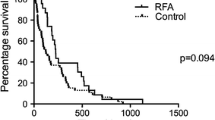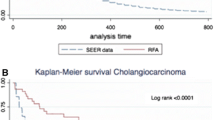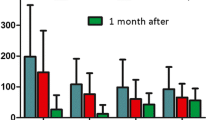Abstract
Background
Radiofrequency ablation (RFA) has been reported to be a beneficial treatment option for palliation of malignant biliary strictures. Biliary obstruction is a common complication in pancreatic and cholangiocarcinoma and many patients require stenting for definitive decompression. The objective of this study was to compare the survival duration of patients as well as safety and efficacy of RFA and metal stent versus stent alone.
Methods
A prospectively established database was analyzed retrospectively and extracted 64 patients with malignant biliary strictures. Patients who underwent RFA with metal stenting were compared to those who were treated conventionally with metal stenting alone. The groups were matched on age, diagnosis, performance status, and palliative chemotherapy. Immediate and 30-day adverse events were recorded. Survival and Cox proportional hazard analyses were calculated.
Results
RFA and control groups were closely matched in terms of age (65.5 ± 13.4 vs. 66.8 ± 12.16 years, p = 0.069) and diagnosis [cholangiocarcinoma (36) and pancreatic cancer (28)]. Technical success rate for both groups was 100 %. Multivariable Cox proportional regression analysis showed RFA to be an independent predictor of survival [HR 0.29 (0.11–0.76), p = 0.012] as well as age and receipt of chemotherapy [HR 1.04 (1.01–1.07), p = 0.011; HR 0.26 (0.10–0.70), p = 0.007]. Overall self-expanding metal stent patency rates were the same across both groups.
Conclusion
RFA appears to improve survival in patients with end-stage cholangiocarcinoma and pancreatic cancer. In a disease with limited treatment options, this modality may prove to be beneficial compared to stenting alone. Randomized controlled trials and evaluation of quality of life measures should be performed to confirm these findings.
Similar content being viewed by others
References
Anderson CD, Pinson CW, Berlin J, Chari RS. Diagnosis and treatment of cholangiocarcinoma. Oncologist. 2004;9:43–57.
Kahaleh M, Tokar J, Conaway MR, et al. Efficacy and complications of covered Wallstents in malignant distal biliary obstruction. Gastrointest Endosc. 2005;61:528–533.
Moss AC, Morris E, Leyden J, MacMathuna P. Malignant distal biliary obstruction: a systematic review and meta-analysis of endoscopic and surgical bypass results. Cancer Treat Rev. 2007;33:213–221.
Schmassmann A, von Gunten E, Knuchel J, Scheurer U, Fehr HF, Halter F. Wallstents versus plastic stents in malignant biliary obstruction: effects of stent patency of the first and second stent on patient compliance and survival. Am J Gastroenterol. 1996;91:654–659.
Moss AC, Morris E, Leyden J, MacMathuna P. Do the benefits of metal stents justify the costs? A systematic review and meta-analysis of trials comparing endoscopic stents for malignant biliary obstruction. Eur J Gastroenterol Hepatol. 2007;19:1119–1124.
Yoon WJ, Ryu JK, Yang KY, et al. A comparison of metal and plastic stents for the relief of jaundice in unresectable malignant biliary obstruction in Korea: an emphasis on cost-effectiveness in a country with a low ERCP cost. Gastrointest Endosc. 2009;70:284–289.
Loew BJ, Howell DA, Sanders MK, et al. Comparative performance of uncoated, self-expanding metal biliary stents of different designs in 2 diameters: final results of an international multicenter, randomized, controlled trial. Gastrointest Endosc. 2009;70:445–453.
Yoon WJ, Lee JK, Lee KH, et al. A comparison of covered and uncovered Wallstents for the management of distal malignant biliary obstruction. Gastrointest Endosc. 2006;63:996–1000.
Curley SA, Izzo F. Radiofrequency ablation of primary and metastatic hepatic malignancies. Int J Clin Oncol. 2002;7:72–81.
Vavra P, Dostalik J, Zacharoulis D, Khorsandi SE, Khan SA, Habib NA. Endoscopic radiofrequency ablation in colorectal cancer: initial clinical results of a new bipolar radiofrequency ablation device. Dis Colon Rectum. 2009;52:355–358.
Shaheen NJ, Overholt BF, Sampliner RE, et al. Durability of radiofrequency ablation in Barrett’s esophagus with dysplasia. Gastroenterology. 2011;141:460–468.
Steel AW, Postgate AJ, Khorsandi S, et al. Endoscopically applied radiofrequency ablation appears to be safe in the treatment of malignant biliary obstruction. Gastrointest Endosc. 2011;73:149–153.
Figueroa-Barojas P, Bakhru MR, Habib NA, et al. Safety and efficacy of radiofrequency ablation in the management of unresectable bile duct and pancreatic cancer: a novel palliation technique. J Oncol. 2013;2013:1–5.
Cotton PB, Eisen G, Romagnuolo J, et al. Grading the complexity of endoscopic procedures: results of an ASGE working party. Gastrointest Endosc. 2011;73:868–874.
Zoepf T, Jakobs R, Arnold JC, Apel D, Riemann JF. Palliation of nonresectable bile duct cancer: improved survival after photodynamic therapy. Am J Gastroenterol. 2005;100:2426–2430.
Kallis Y, Phillips N, Steel A, et al. Analysis of long-term outcomes after endoscopic radiofrequency ablation for bile duct strictures in pancreatic malignancy suggests potential survival benefit AB165. Gastrointest Endosc. 2013;77:763.
Conflict of interests
None.
Author information
Authors and Affiliations
Corresponding author
Additional information
IRB: Protocol No. 1107011793, approved on 07/2011 by WCMC-IRB.
Rights and permissions
About this article
Cite this article
Sharaiha, R.Z., Natov, N., Glockenberg, K.S. et al. Comparison of Metal Stenting with Radiofrequency Ablation Versus Stenting Alone for Treating Malignant Biliary Strictures: Is There an Added Benefit?. Dig Dis Sci 59, 3099–3102 (2014). https://doi.org/10.1007/s10620-014-3264-6
Received:
Accepted:
Published:
Issue Date:
DOI: https://doi.org/10.1007/s10620-014-3264-6




